Be truck aware
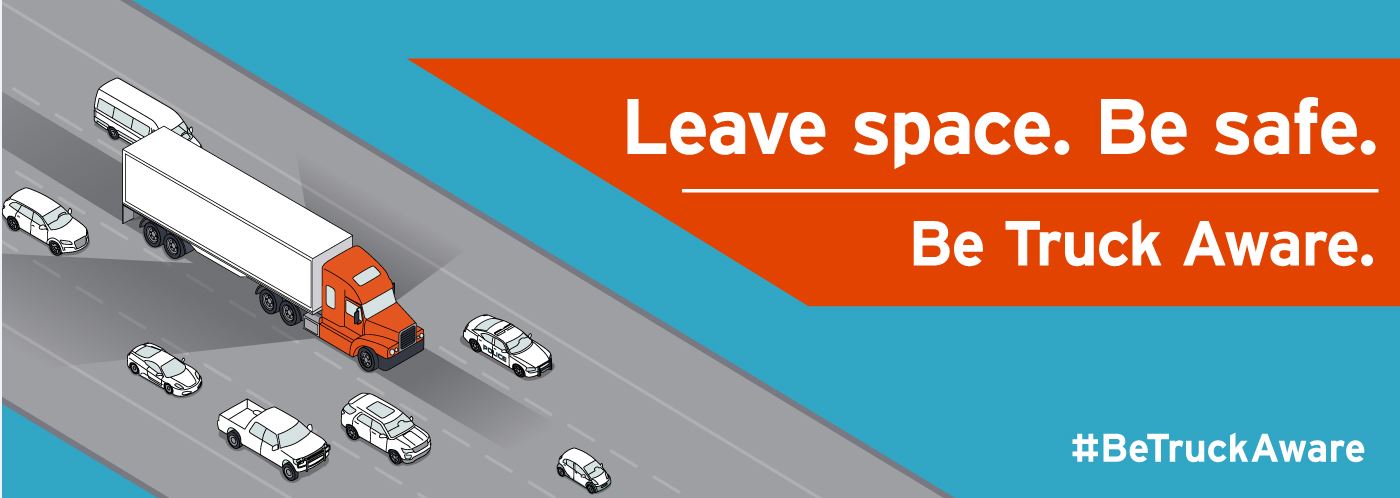
Leave space. Be safe. Be truck aware.
Be Truck Aware is a multi-stakeholder initiative aimed at raising awareness of the hazards of passenger vehicles and large commercial trucks not sharing the road safely – and how to reduce the risk of being involved in a crash with a large truck.
Overview
Each year in British Columbia, approximately 60 people are killed in traffic crashes involving large commercial vehicles. Studies show that, in collisions between cars and large trucks, the occupants of the passenger vehicle are at least four times more likely to be killed than the driver of the truck. Studies also show that in fatal car-truck crashes, the driver of the passenger vehicle is at fault in at least two-thirds of the incidents.
Drivers are urged to Be Truck Aware. Large trucks need extra room to stop and to turn, and have many blind spots. By driving safely and taking a few extra precautions around large trucks, passenger vehicle drivers can significantly reduce the risks of being involved in a serious crash.
Drivers who take unsafe actions around other vehicles not only endanger themselves and others, they risk being ticketed and fined. Police and Commercial Vehicle Safety & Enforcement (CVSE) officers are out enforcing and will ticket drivers of both cars and trucks for failing to share the road and follow safe driving practices.
Resources
Tips for passenger vehicle drivers
Trucks need more room to turn, change lanes and stop. By understanding that large trucks need more room to operate, and by taking a few extra precautions around trucks, passenger vehicle drivers can significantly reduce the risks of being involved in a serious crash.
- Give trucks lots of space — don’t take away their turning or braking room.
- Don’t merge too soon — when passing a truck, make sure you can see both its headlights in your rear-view mirror before merging back into the lane.
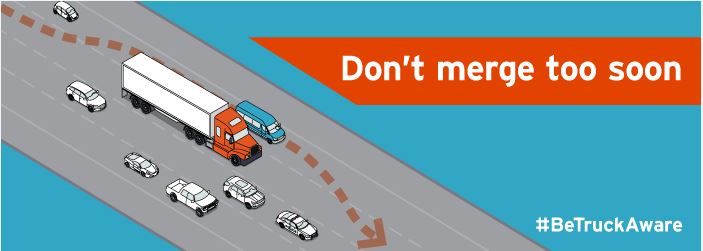
- Be visible around trucks — trucks have blind spots that prevent truck drivers from always being able to see other vehicles around them. Limit the time you spend directly in front of, behind or beside large trucks. Slow down or move ahead to stay out of a truck’s blind spots.
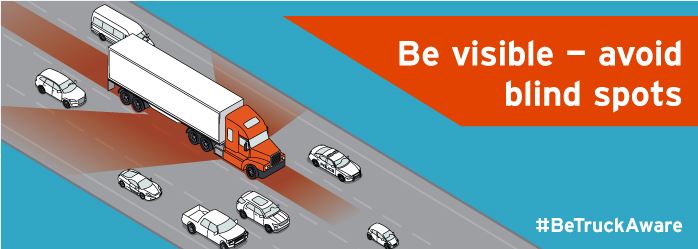
- Make way for trucks changing lanes – when you see a truck signaling to make a lane change, give them room by slowing down or moving ahead.
- Anticipate wide turns — watch for trucks making wide swings to turn right. Avoid driving ahead in the right lane beside a turning truck.
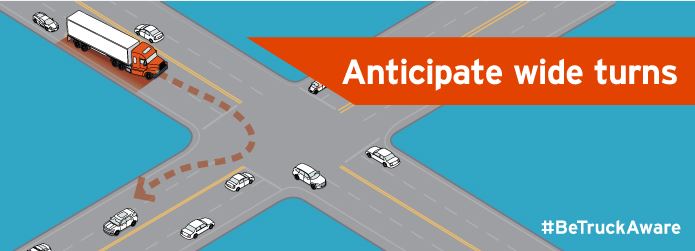
Tips for commercial truck drivers
Work-related crashes can result in injuries, fines and time loss. As a professional truck driver, you know how important safety is, and understand the benefits of taking precautions to reduce crashes and their severity.
- Ensure brakes and tires are in top condition to help reduce stopping distances.
- Adjust your speed for changing weather and road conditions.
- Stay sharp and focused by getting plenty of rest and eliminating in-cab distractions.
- Make sure loads are well balanced and secure to reduce the likelihood of a crash and its impact on others.
Videos
This video shows several scenarios in which B.C. drivers are putting themselves at risk by not driving safely around large commercial trucks.
Video #2 – Braking and stopping distance demonstration
This video demonstrates how much longer a large commercial truck takes to stop than a passenger vehicle – and why you should never merge too soon or cut in front of a truck.
Video #3 – Blind spots demonstration
This video shows how difficult it can be for a truck driver to see you when you’re in one of the truck’s blind spots.
Video #4 – Right hand turn demonstration
This video shows the extra room a truck needs to safely make a right hand turn in an intersection – and the danger other drivers may put themselves in by not paying attention.
Stats and Studies
1. In an average year in B.C., large trucks are involved in less than one percent of all crashes – but they’re involved in nearly 20 percent of fatal crashes.
Source: ICBC and Police Reported data, 2011-2015. Note: This statistic includes the following vehicle types: (21) Single Unit Truck/Heavy; (31) Combination Unit Truck/Heavy; (32) Combination Unit Tractor/Trailer; (33) Combination Unit Tractor/Trailer & Pup; (34) Log Truck and Pole Trailer.
2. On average between 2011 and 2015, 285 people were killed each year on B.C.’s roads and highways – 61 of them in crashes involving at least one large commercial vehicle.
Source: ICBC Quick Statistics, January 2017. Note: heavy vehicle is defined as having a licensed gross vehicle weight of greater than or equal to 10,900 kg. Fatal victim counts use the police definition of heavy vehicle: Single Unit Truck/Heavy, Combination Unit Truck/Light or Heavy, Tractor/Trailer, Tractor/Trailer and Pup, Logging Truck and Pole Trailer, Tow Truck, Combination Unit Truck/Pull Trailer/5th Wheel, Transit Bus, Local Intercity Bus, Road Construction (Grader, Paver, Roller), General Construction and Mobile Crane. Injured and fatal victims include anyone injured in the crash— not only heavy-vehicle occupants.
3. Studies across North America show that, in collisions between cars and large trucks, the occupants of the passenger vehicle are at least four times more likely to be killed than the driver of the truck.
Sources: a) US Department of Transportation, Federal Motor Carrier Safety Administration (FMCSA) Pocket Guide to Large Truck and Bus Statistics, June 2017. Table 4-9: Vehicle Occupants Killed in Large Truck Crashes by Vehicle Type, 2012-2015. b) Traffic Injury Research Foundation (Ottawa) - Road Safety Bulletin: A Question of Size, April 2016.
4. Additional studies show that in fatal car-truck collisions, two-thirds or more of the incidents are found to be the fault of the passenger vehicle.
Source(s): A literature review conducted by RoadSafetyBC of studies of causes and responsibilities in car-truck crashes was conducted in July 2017. The review included an analysis of seven studies conducted in the U.S. and Canada between 1998 and 2017, and offered the following conclusion: “The research on car-truck crash causes and responsibility for passenger vehicle and truck drivers has consistently found that passenger vehicle drivers are more often the primary contributors to the crash. In car-truck crashes, driver-related factors (for example speeding or unsafe manoeuvres) are reported for passenger vehicle drivers about 65 to 85 percent of the time according to the various studies, and are reported for trucks in only about 20 to 25 percent of car-truck crashes.”
5. A fully loaded transport truck travelling at 65 km/h (40 mph) takes 36 percent longer to brake and stop than a passenger car travelling at the same speed. A fully loaded transport truck travelling at 105 km/h (65 mph) takes 66 percent longer to brake and stop than a passenger car travelling at the same speed.
Source: Utah Department of Transport, Trucks Need More Time to Stop, 2017
6. A survey of B.C. drivers conducted for the Be Truck Aware Alliance in June found that 80 percent of drivers surveyed claim to know how to drive safely around large trucks, but over 40 per cent don’t always drive that way. In addition, nearly a third of drivers surveyed say they feel nervous driving around big trucks all or most of the time.
Source: Be Truck Aware Alliance Omnibus Survey on Safe Driving Skills Around Commercial Trucks, conducted by Insights West, June 2017. Survey of 764 British Columbian adults who have a provincial driver’s licence. The data was statistically weighted according to Canadian census figures for age and gender. The margin of error—which measures sample variability—is +/- 3.5 percentage points, nineteen times out of twenty.
7. Car-truck crashes are more likely to be caused by the actions or inactions of the drivers involved (both truck and passenger vehicle drivers), as opposed to other factors such as weather, road conditions and vehicle performance.
Source: Large Truck Crash Causation Study, US Department of Transportation, Federal Motor Carrier Safety Administration (FMCSA), March 2006 (Updated April 2014)
News Release
About the Be Truck Aware Alliance
Be Truck Aware is an initiative of the B.C. Road Safety Strategy (B.C. RSS) Safe Vehicles Working Committee. The Be Truck Aware Alliance is a coalition of B.C. road safety stakeholders who are committed to reducing injuries and fatalities on B.C. roadways and to reducing workplace injuries and deaths among commercial vehicle drivers.
Be Truck Aware Alliance members:
- B.C. Trucking Association
- Commercial Vehicle Safety & Enforcement
- ICBC
- Justice Institute of British Columbia
- RoadSafetyBC
- RCMP
- SafetyDriven – Trucking Safety Council of B.C.
- Teamsters Local 31
- WorkSafeBC
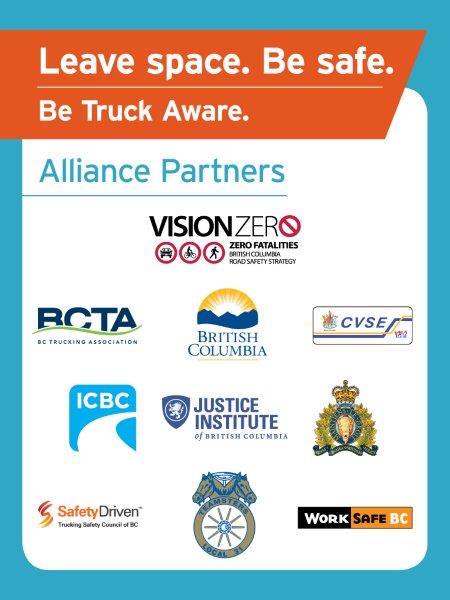
Rules and Penalties
All drivers are responsible for knowing and respecting traffic laws and for sharing the road safely with other road users. Police and Commercial Vehicle Safety & Enforcement (CVSE) officers are enforcing and will stop and ticket drivers of both passenger vehicles and commercial vehicles who endanger others by engaging in illegal and unsafe driving behaviours.
Common road-sharing related infractions include:
| Motor Vehicle Act Section | Description | Fine | Point Level |
|---|---|---|---|
| 162(1) | Follow too closely | $109 | 3 |
| 151(a) | Unsafe lane change | $109 | 2 |
| 151(c) | Change lanes without signal | $109 | 2 |
| 144(1)(b) | Drive without due consideration (e.g. driving without reasonable consideration for other persons using the highway, blocking a lane, etc.) | $196 | 6 |
| 125 | Disobey traffic control device (e.g. trucks and slow vehicles failing to use the right lane, as posted on the signage) | $121 | 2 |
| 150(1) | Fail to keep right | $109 | 3 |
| 162(2) | Commercial vehicle follow too closely (60m or less) | $109 | 3 |
